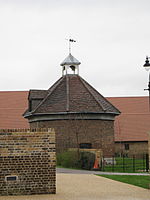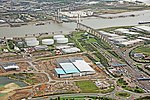Purfleet
EngvarB from October 2013Food processing in LondonPopulated places in EssexPort of LondonPurfleet ... and 1 more
Thurrock

Purfleet-on-Thames is a town in the Thurrock unitary authority, Essex, England. It is bordered by the A13 road to the north and the River Thames to the south and is within the easternmost part of the M25 motorway but just outside the Greater London boundary. It was within the traditional Church of England parish of West Thurrock. Some industry is located to the south and the area forms part of the Thames Gateway redevelopment area. Purfleet is one of seven conservation areas in Thurrock.
Excerpt from the Wikipedia article Purfleet (License: CC BY-SA 3.0, Authors, Images).Purfleet
Windermere Avenue, Thurrock
Geographical coordinates (GPS) Address Nearby Places Show on map
Geographical coordinates (GPS)
| Latitude | Longitude |
|---|---|
| N 51.48 ° | E 0.25 ° |
Address
Windermere Avenue
Windermere Avenue
RM19 1QN Thurrock
England, United Kingdom
Open on Google Maps






